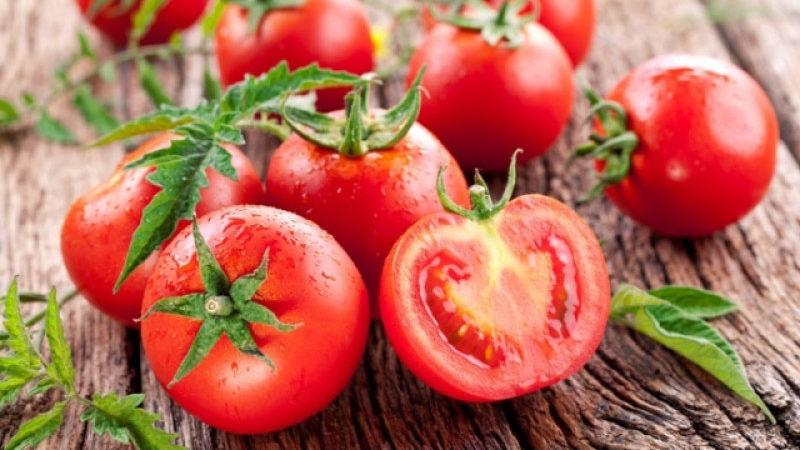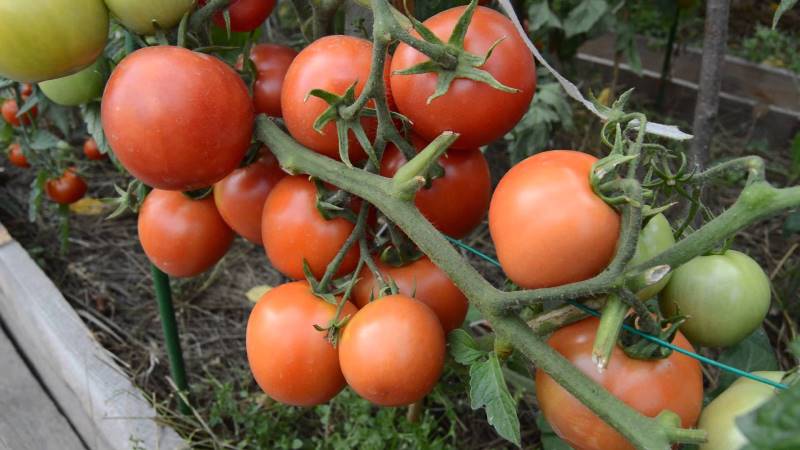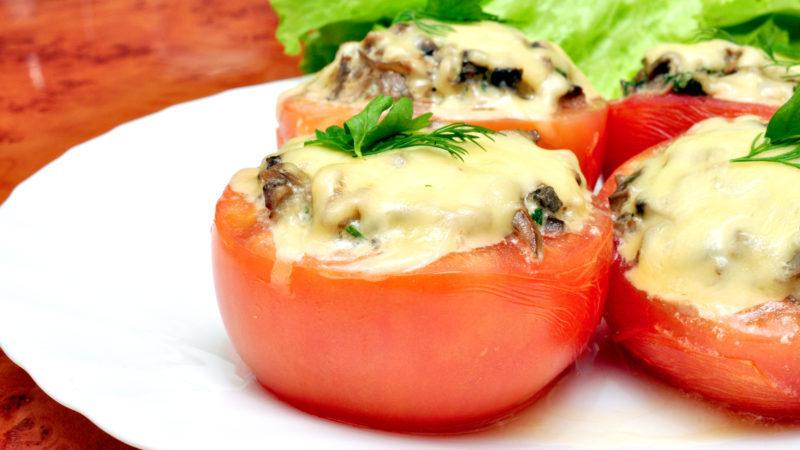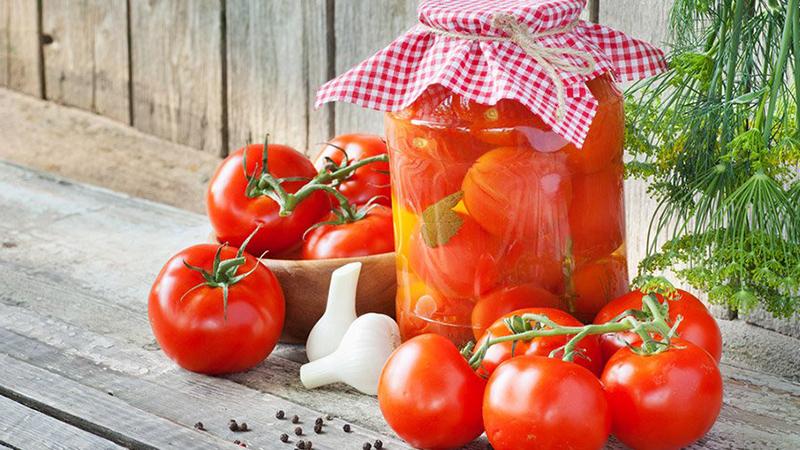Disease Resistant and Easy to Care Gina Tomato - A Practical Guide to Growing
Many breeders are trying to develop varieties of tomatoes that are easy to care for and resistant to pests, but at the same time give a rich and tasty harvest. There are already such varieties, and one of them isgrade Gina.
The variety was bred by Dutch breeders, but it has gained popularity all over the world. The description of the Gina tomato variety, photos and reviews will be considered below.
The content of the article
Features of the variety
Gina is relatively young grade in the agricultural industry, but already gaining popularity. Refers to undersized (determinant) tomatoes. The bushes form three stems growing from the roots, reaching a height of 50-60 cm.
Plants are easy to care for, do not require such standard procedures for tomatoes as garter, shaping, pinching.
The Gina tomato variety is large-fruited, mid-ripening - 110-120 days pass from the appearance of the first shoots to full ripening of the fruits. The first brush begins to be laid above 8 leaves, the rest - after 1-2 leaves.
Suitable for growing both in the greenhouse and in the open field. It does not tolerate temperature extremes, therefore, when planting in open ground, additional temporary shelter may be required, for example, a temporary greenhouse.
The variety is resistant to late blight, verticillium, fusarium, root rot.
Fruits of a round shape are bright red in color, the surface is even, not ribbed. The weight of one fruit is about 200-300 g. One tomato has 6-8 chambers with seeds. 3-5 fruits are formed on one brush, not all ripening at once, but in stages.
The skin of the fruit is thick and dense. The pulp is fleshy, soft, aromatic and juicy. The taste of the pulp is sweet, pleasant, with a slight sourness.
Thanks to their thick, dense skin, tomatoes tolerate transportation well and are stored for a long time. If stored properly, they do not lose their marketable qualities and excellent taste for a very long time.
Note... If the ripe fruit is placed in a sterile glass jar and placed in a cool place, the tomato will remain fresh for three months.
The photo shows the Gina variety

The Gina variety has a hybrid called Gina TS. A hybrid is an organism or cell that has been obtained by crossing genetically distinct forms to obtain certain properties. Hybrid seeds cannot be used for planting.
Gina TS is a variety of varieties that has a high yield and an orange-red color of small fruits (200 g). The plant is suitable for indoor and outdoor cultivation. The ripening period of tomatoes, in contrast to the Gina variety, is 100-105 days.

How to grow seedlings
Gin's tomato seeds are sown at the end of winter or early spring, if growing in a greenhouse is planned, and in April, if planting in open ground. Before sowing, the seeds are soaked in a weak solution of potassium permanganate, then dried.
Use a wooden box or plastic container to plant seeds. Place a plastic film on the bottom of the drawer, in which you make holes so that excess water flows through them. Place river sand and gravel on the plastic as drainage. Pour soil on top so that there is at least 2 centimeters left to the top of the container. Use a versatile vegetable growing soil.
Important! Water the soil before placing it in the box. potassium permanganate solution and leave for 2 days indoors. The sowing soil must be moist and loose.
Plant the seeds at a distance of 1-3 cm from each other, cover with a thin layer of soil on top. Cover the top of the boxes with foil - this way the seeds will germinate faster - and put them in a warm place. When the first shoots appear, remove the film.
If the sprouts have sprouted close to each other, make a pick, that is, transplant the sprouts into separate containers, for example, cups. This must be done when the first 2-3 main leaves appear. If the planting is not dense, you can plant it when 5-6 leaves appear.
The soil should be moist, but not waterlogged. Water the grown seedlings under the root from a spray bottle.
Seedlings are harmed by such a parasite as a black leg. To combat it, pollinate the seedlings with wood ash.
Feed the sprouts with mineral and organic fertilizers 2 times for the entire period of seedling growth from planting seeds to planting in a permanent place. Apply fertilizer for the first time 10 days after seed germination, and the second time 2 weeks before planting.
How to grow tomatoes
To grow a rich harvest, it is important to properly prepare the land in the fall. Dig up the area with fertilization: 0.5 buckets of compost, 1-2 tablespoons of potassium sulfate per m². In addition, one must not forget about the fertilizers that are put into the hole when planting seedlings.
The composition and properties are suitable for the drug "Hurricane". Put half a teaspoon of the product in each well. Plants thrive in neutral or slightly acidic soil (6.5 pH).
Cleaning is recommended before planting seedlings in the greenhouse. Wash the walls of the greenhouse with soapy water, and spill the ground with boiling water or potassium permanganate solution. This is necessary to kill the parasites.
Plant seedling bushes in rows in a checkerboard pattern, about 3-4 bushes per meter. Place the sprout in the hole and add earth to it.
To water start only after the seedlings have taken root in the soil. Water correctly once a week, 5-7 liters per 1 m². Water in the morning or evening with warm, settled water under the root so that moisture does not get on the leaves and stems.
Attention! To preserve moisture in the soil near the bush, it is recommended to put straw around the stem in a layer about 4-5 cm thick.
For root breathing, loosen the soil around the stems after each watering. Loosening improves the temperature and humidity of the soil.
After the first fruits have set, pick off excess leaves so that the plant wastes nutrients on the fruits and not on the foliage.
Fertilize the tomatoes for the first time 2-3 weeks after placing the seedlings in the greenhouse, the second time after another 10 days. For fertilization, use a solution of water, manure and "Nitrofoski".
10 days after planting in the ground, use the fertilizer "GUMI Kuznetsova" (for 10 liters of water, 2 tablespoons). After 14 days - ammonium nitrate (for 10 liters of water 1 tbsp. L.). During the formation of the ovary - potassium humate, "Nitroammofosku" (10 liters of water, 15 g each). During the ripening period of fruits - superphosphate, potassium chloride (for 10 liters of water, 1 tbsp. L each).
Since the variety is undersized, pinching and garter are not required.
Note... Experienced gardeners recommend using iodine to increase yields. Add 5 drops of iodine to one bucket of water and stir. Water at the root with 2 liters per plant.
During cultivation, difficulties may arise with pests... The Gin variety is harmed by such insects as aphids, bear, Colorado potato beetle. To protect against aphids, use soapy water or decoctions of wormwood leaves, onion husks and garlic. For the fight against bears - preparations in granules, for example, "Medvetox". Colorado potato beetle is exterminated with the help of "Confidor" and "Corado" preparations.
The photo shows a Gina bush

The nuances of growing in open ground and in a greenhouse
Planting in open ground differs from planting in a greenhouse only in time, all other procedures are carried out in the same way. Growing Gin's tomatoes outdoors is more suitable for the southern regions.To do this, planting is carried out both in a seedling way and in a seedless way.
Seedless way
In addition to the seedling method of growing tomatoes, there is a seedless method. With this method, seeds are planted directly into the ground or greenhouse. A good time to sow seeds is spring or early summer.
For sowing in this way, furrows (25-30 cm in length) are made in the soil. Ash and fertilizers are poured onto the bottom of the furrow, and sod soil is poured on top. Before adding seeds to the soil, it must be watered with settled water.
In the furrows, pits are made with a depth of 2-3 cm. 3-4 seeds are placed in the hole and sprinkled with earth. To protect against drying out and weeds, the pits are covered with straw, and to protect against frost - with film.
Harvesting and application of the crop
After 100 days, the first crop is harvested. The variety is high-yielding, experienced gardeners harvest from 10-20 kg of fruits from 1 m². On the open ground, the fruits ripen until the first frost; in a greenhouse with heating, tomatoes ripen all year round.
The use of the crop is varied, since Gina variety is universal... Due to its dense skin, it is suitable for canning, while it is better to choose smaller fruits. Also ideal for salads and other dishes: stuffed tomatoes, soups.

Advantages and disadvantages of the variety
The main characteristic of the variety is, of course, the taste of the fruit. The pleasant combination of sweetness and sourness ensures wide popularity among consumers. The Gina variety is unpretentious in care, but always gives a consistently good harvest. The plant does not require pinching, pinching and garter, which makes growing easier and saves gardeners time.
The variety is versatile and suitable for growing in open ground and greenhouses, greenhouses, seedlings and seedlings. The tomato is resistant to many diseases and pests, which allows you not to waste time on disease prevention and treatment. Due to the dense and strong peel, the fruits tolerate transportation and storage well. Gina is a lettuce tomato; tasty and healthy tomato juice is also prepared from its fruits.
The variety also has disadvantages. The tomato is sensitive to cold snap (the temperature should not fall below 16 degrees), so sometimes you have to use additional shelters. However, this can be avoided by growing tomatoes in a greenhouse. Bushes can grow strongly and tend to the ground. In such cases, the bush is laid out on the ground so that the stems do not break.

Farmers reviews
The Gin variety has more advantages than disadvantages. Here are the reviews of gardeners who grow these tomatoes.
Ilya Alexandrovich, Saratov: “A neighbor at the dacha advised me the Gina variety, so I decided to try it. Planted in open ground, the fruits appeared in 107 days, rather quickly. I liked that the tomatoes are ripe, fleshy and delicious. There was a lot of harvest, I didn't know what to do with it, I decided to make tomato paste. It turned out very tasty, now I cook it constantly. But, as I said, there is a lot of harvest, so we add to salads and soups, we are always happy with the result ".
Anna, Kursk: «I do not like tomatoes, which need to be tied up and pinned, I like them to be easier to care for, so I chose the Gina variety and was not disappointed. There was no hassle, but the result is wonderful! The harvest was rich. Tomatoes are suitable for canning, salads, and fresh consumption. The only thing is that when canning large tomatoes do not pass well through the neck of the jar, so it is better to select smaller fruits. "
Galina, Nizhny Novgorod: «I use this variety for harvesting for the winter. Tomatoes have a thick and tough skin so they don't burst. It is very convenient to preserve, only you need to select smaller fruits. I don't really like it fresh, just because of this peel, but it's a matter of taste. The variety is also very easy to care for, there are no problems, it grows by itself. I recommend the Gin variety. "
Conclusion
In conclusion, it should be noted that it is difficult to argue about the tastes of tomatoes, each gardener has his own preferences, but the Gin variety will not leave anyone indifferent due to its simple cultivation. The plant requires virtually no maintenance, but it gives a rich harvest. Perfect for beginners in horticulture and ideal for commercial production.